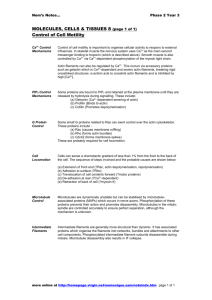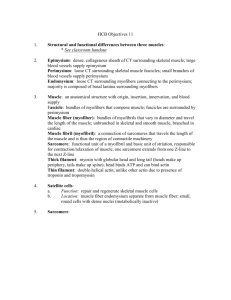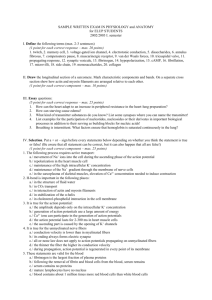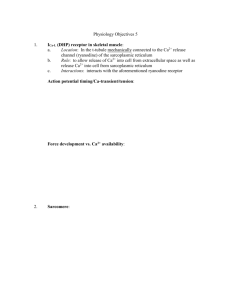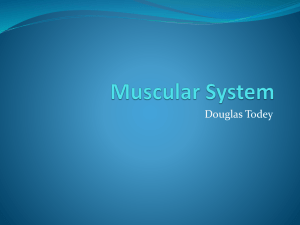Neuron Structure and Function
advertisement
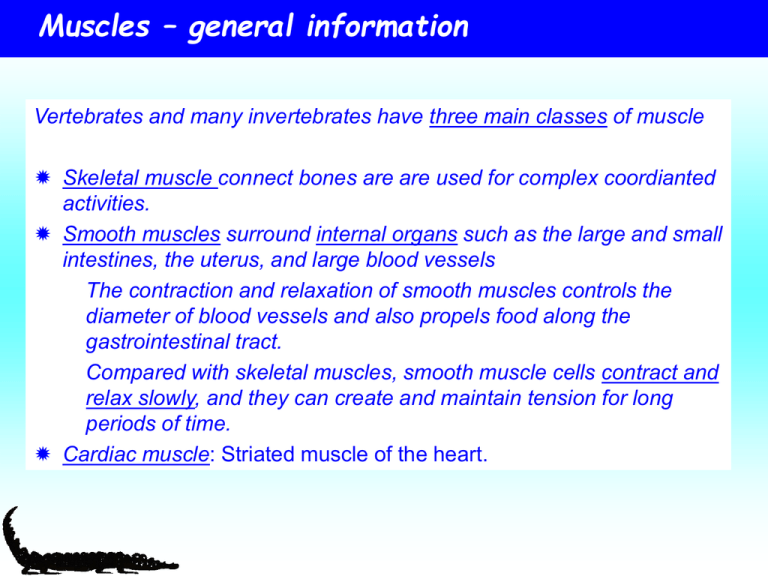
Muscles – general information Vertebrates and many invertebrates have three main classes of muscle Skeletal muscle connect bones are are used for complex coordianted activities. Smooth muscles surround internal organs such as the large and small intestines, the uterus, and large blood vessels The contraction and relaxation of smooth muscles controls the diameter of blood vessels and also propels food along the gastrointestinal tract. Compared with skeletal muscles, smooth muscle cells contract and relax slowly, and they can create and maintain tension for long periods of time. Cardiac muscle: Striated muscle of the heart. Muscles - introduction B. Skeletal muscle from the neck of a hamster C. Heart muscle from a rat D. Smooth muscle from the urinary bladder of a guinea pig E. Myoepithelial cells in a secretory alveolus from a lactating rat mammary gland Microtubule Function • Move subcellular components • Use motor proteins kinesin and dynein • e.g., Rapid change in skin color Microtubules Show Dynamic Instability Balance between growth and shrinkage Factors • Local concentrations of tubulin • Dynamic instability • Microtubule-associated proteins (MAPs) • Temperature Chemicals can disrupt the dynamics (e.g., plant poisons) Movement Along Microtubules Direction is determined by polarity and the type of motor protein • Kinesin move in + direction • Dynein moves in – direction Fueled by ATP Rate of movement is determined by the ATPase domain of the protein and regulatory proteins Dynein is larger than kinesin and moves 5-times faster Cilia and Flagella • • • • • Cilia – numerous, wavelike motion Flagella – single or in pairs, whiplike movement Composed of microtubules Arranged into axoneme Movement results from asymmetric activation of dynein Microtubules and Physiology Microfilaments • • • • • Other type of cytoskeletal fiber Polymers composed of the protein actin Often use the motor protein myosin Found in all eukaryotic cells Movement arises from • Actin polymerization • Sliding filament model using myosin (more common) Microfilament Structure and Growth • Polymers of G-actin called F-actin • Spontaneous growth (6-10X faster at + end) • Treadmilling when length is constant • Capping proteins increase length by stabilizing minus end Microfilament Arrangement Actin Polymerization Amoeboid movement Two types • Filapodia are rodlike extensions • Neural connections • Microvilli of digestive epithelia • Lamellapodia resemble pseudopodia • Leukocytes • Macrophages Skeletal muscle (striated muscle) • Skeletal muscle cells are one of the largest cells in the body • Are multinucleate formed by the fusion of myoblasts • Diameters range from 50 to 150 microns with lengths ranging from mm to cm • Muscle fibers contract in response to an electrical signal ie depolarization • The signal is generated at the synapse (the neuromuscular junction) and propagated through an action potential via the muscle fiber membrane • The membrane of the cell has specialized invaginations called Transverse-tubules (T-tubules) that enter into the cell (at every 12 microns) • The action potential can be rapidly transmitted deep into the interior of the cell resulting a delay of only 3-5 msec between the depolarization at the synapse and the first muscle fiber tension. • The T-tubule network is so extensive that 50-80% of the plasma membrane is in the T-tubules. Neuromuscular junction – things to remember • Each muscle fiber is innervated by a motorneuron • One motorneuron can innervate one or multiple fibers • Each motorneuron plus its complement of muscle fibers is called a motor unit as well all contract in concert. • The synpase between the motorneuron and the muscle fiber is called a neuromuscular junction(NMJ) • Nerve terminal contains many mitochondria and vesicles which can be seen lined up in double rows along side the voltage-gated Ca2+ channels attached to presynaptic membrane => active zone. • The vesicles of the NMJ have very high concentrations of neurotransmitter (2,000 to 10,000 molecules of ACH per vesicle) • Excess of neurotransmitter is released to ensure that the resulting post-synaptic depolarization is strong enough to generate an action potential - "safety margin" Neuromuscular junction – things to know The nACHR - again • The receptor is made up of 4 different transmembrane proteins one of which (the alpha subunit) is repeated to give 5 subunits to create the ion channel • ACH binds to the alpha subunit and thus it takes two molecules of acetylcholine to open the channel • One nACHR opens and allow 1.5 x 104 Na+ ions/msec of open time • The channel opens on average 1 msec. • 1 vesicle contains enough neurotransmitter to open ~3000 receptors (wow!) and because two molecules of Ach is needed to open one receptor there must be a minimum of ~6,000 molecules Ach per vesicle. • Studies have shown that the amount of neurotransmitter contained in one vesicle causes an post-synaptic potential of ~ 1 mV. • If the average depolarization generated at a NMJ of a muscle fiber is 40 mV then there must be at least 40 vesicles released and in the order of 120,000 receptors activated at the NMJ. WOW! Striated muscle channels and action potentials Striated muscle channels and action potentials Pumps and transporters 1) Na+/K+ ATPase pump - to establish the electrochemical gradients of Na+ and K+ 2) Ca2+ ATPase pump - uses energy from ATP to remove 2 Ca2+ from the inside to the outside of the cell to ensure that internal Ca2+ concentrations remain low (10-7 mM internal) 3) Na+/Ca2+ cotransporter - to also remove Ca2+ from the inside of the cell and uses the energy from the cotransport of 3 Na+ molecules to export 1 Ca2+ 4) Muscle Ca2+ ATPase pump - a different pump from number 2 above. Found highly concentrated on the sarcoplasmic reticulum (SR) (constitutes 80% of the protein found in the SR membranes). The muscle Ca2+ ATPase pumps 2 Ca2+ into the SR to lower cytosolic Ca 2+ and to concentrate Ca 2+ into internal stores. Striated muscle channels and action potentials Channels - muscle cells share many of the same ion channels as neurons 1) leak channels - besides the leak K+ channel, skeletal muscle cells have a high concentration of Cl- leak channels so much so that the resting membrane potential is usually the same as the Nernst potential for Cl(around -80 mV in these cells). The high permeability to Cl- helps repolarize the membrane after an action potential 2) Voltage-gated Na+ channels - Voltage-gated Na+ channel (very much like the neuronal voltage-gated Na+ channel) Responsible for the production of the action potential. Remember the regenerative cycle of these channels ie during an Action potential 3) Voltage-gated K+ channel - the delayed rectifier K+ Has a high threshold and needs a strong depolarization to open and works to bring the membrane back to resting potential 4) Voltage gated Ca2+channels - high threshold Ca2+ channels Needs a strong depolarization to open and very slowly Concentrated in the T-tubules. Skeletal muscle (striated muscle) Terminology • Muscle cell: Muscle fiber • Myofibrils: Main intracellular structures in striated muscles. Are bundles of contractile and elastic proteins • Sarcolemma: Cell membrane of a muscle cell • Cytoplasm: Sarcoplasm • Sarcoplasmic reticulum: wraps around each myofibril like a piece of lace. Release and sequester Ca2+ ions Skeletal muscle (striated muscle) • • • • The sarcoplasmic reticulum (SR) regulates the cytosolic Ca2+ levels in skeletal muscle Myofibril: A long bundle of actin, myosin and associated proteins in muscle cell. Transverse (T) tubules: invaginations of the plasma membrane, enter myofibers at the Z disks, where they come in close contact with the terminal cisternae of the SR Terminal cisternae: store Ca2+ ions and connect with the lacelike network of SR tubules that overlie the A band. T-Tubules and SRs Transverse tubules • Sarcolemmal invaginations • Enhance action potential penetration • More developed in larger, faster twitching muscles • Sarcoplasmic reticulum (SR) • Stores Ca2+ • Terminal cisternae - storage Triads and Sarcoplasmic reticulum • • • • • The link between depolarization and Ca2+ release or excitationcontraction coupling occurs at the junctions between the T-tubule and the sarcoplasmic reticulum 80% of the T-tubules membrane is associated with the sarcoplasmic reticulum at triads The voltage-gated Ca2+ channels are concentrated in the T-tubules in the triads The Ca2+ release channel found in the sarcoplasmic reticulum membrane is associated with the voltage-gated Ca2+ channel at this point This close association allows for the rapid signaling from action potential to Ca2+ release. General sequence of events • • • • • • • • Resting [Ca2+]i = 0.1 μM AP propagation along Sarcolemma and into T- tubules Depolarization opens the voltage-gated Ca2+ channels at triad junctions This results in a release of Ca2+ through the Ca2+ release channels from the SR Cytosolic [Ca2+]i reaches 1-10 μM Diffusion and binding of Ca2+ to TnC Contraction events [Ca2+] to resting levels: 1. After the action potential is passed and the voltage-gated Ca2+ channels close, the Ca2+ release channels close 2. Ca2+ is recycled back into the SR through the Ca2+ ATPases 3. Ca2+ binds to calsequesterin Ca2+ channels and its release • • • • • • Release of Ca2+ stores mediated by ryanodine receptors (RYRs) in skeletal muscle Voltage sensing dihydropyridine (DHP) receptors in the plasma membrane contact ryanodine receptors located in the membrane of the SR In response to a change in voltage, the dihydropyridine receptors undergo a conformational change This produces a conformational change in the associated RYRs, opening them so that Ca2+ ions can exit into the cytosol. The voltage-gated Ca2+ channel is either closely localized to or makes a physical connection to the Ca2+ release channels in the SR Cont…….. Ca2+ channels and its release • Not all Ca2+ release channels are associated with voltage-gated Ca2+ channels • These non-associated channels are thought to be opened solely by Ca2 influx into the cytosol from the voltage-gated Ca2+ channels. • The Ca2+ release channel in the SR of most muscle cells (smooth, cardiac, skeletal) is a Ca2+ activated Ca2+ channel • The Ca2+ release channel is stimulated to open at low concentrations of Ca2+ ( up to 0.1 mM) in the cytosol but inhibited by high concentrations of Ca2+ in the cytosol (0.5 mM and higher for cardiac cells) • So as Ca2+ is released from the SR it starts to inhibit the Ca2+ release channel. Depolarization induced Ca2+ release Ca2+ induced Ca2+ release Experiment Sarcomeres • • • • • Skeletal muscle is made up of bundles of multinucleate muscle cells (myofibers) Each cell contains myofibrils that are composed of repeated units of actin and myosin called sacromeres Thick and thin filaments arranged into sarcomeres Repeated in parallel and in series Features • Z-disk • A-band • I-band • M-lines Sarcomeres • Electron micrograph of a longitudinal section through a skeletal muscle cell of a rabbit • Schematic diagram of a single sarcomere • Z discs: At each end of the sarcomere • Attachment sites for the plus ends of actin filaments (thin filaments) • M line: Midline. • Location of proteins that link adjacent myosin II filaments (thick filaments) to one another • Dark bands: mark the location of the thick filaments = A bands • Light bands: which contain only thin filaments and therefore have a lower density of protein = I bands. Sarcomeres Myofibril • A single continuous stretch of interconnected sarcomeres • Runs the length of the muscle cell • More myofibrils in parallel more force Striated Muscle Cell Structure Composed of thick and thin filaments • Thick: myosin • 300 myosin II hexamers • Thin: actin • Capped by tropomodulin (-) and CapZ (+) to stabilize • Decorated by troponin and tropomyosin • Globular protein (G-actin) • Form long chains called F-actin • In skeletal muscle 2 Factin polymers twist together Actin and Myosin Function Myosin • Motor protein used by actin • Sliding filament model • Most common type of movement • Myosin is an ATPase • Converts E released • from ATP to mechanical E • 17 classes of myosin with • multiple isoforms • Similar structure • Head, tail, and neck Sliding Filament Model Analogous to pulling yourself along a rope • Actin: the rope • Myosin: your arm Sliding Filament Model • • • Two processes • Chemical • Myosin binds to actin (Cross-bridge) • Structural • Myosin bends (Power stroke) Cross-bridge cycle • Formation of crossbridge, power stroke, and release Need ATP to attach and release • No ATP rigor mortis Sliding filament model Sliding Filament Model, Cont. • Myosin is bound to actin in the absence of ATP and this is the "rigor" state i.e. gives rigidity to the muscle • ATP binds to the myosin causing the head domain to dissociate from actin • ATP is then hydrolyzed causing a conformational change in the mysoin head to move it to a new position and bind to actin • Pi is released causing the myosin head to change conformation again and it is this movement that moves the actin • ADP is released Ca2+ Allows Myosin to Bind to Actin • Ca2+ binds to TnC • Reorganization of troponin-tropomyosin • Expose myosin-binding site on actin Ca2+ Allows Myosin to Bind to Actin * * * * • • • • • Ca2+ levels increase in cytosol Ca2+ binds to troponin C Troponin-Ca2+ complex pulls tropomyosin away form G-actin binging site Myosin binds to actin and completes power stroke Actin filament moves * Sliding Filament Model Contractile Force • Depends on sarcomere length: distance between the Z-disks • Number of myofibrils • Number of cells (recruitment) Isotonic and isometric contraction Regulation of Contraction • Excitation-contraction coupling • Depolarization of the muscle plasma membrane (sarcolemma) • Elevation of intracellular Ca2+ • Contraction • Relaxation when the sarcolemma repolarizes and Ca2+ returns to resting levels Excitation – contraction coupling • • • • • • • • ACH released at the NMJ Net entry of Na+ initiates a muscle action potential AP in T- tubule alters conformation of DHP receptor DHP receptor opens Ca2+ release channels in SR and Ca2+ enters the cytoplasm Ca2+ binds to troponin C Troponin-Ca2+ complex pulls tropomyosin away form G-actin binging site Myosin binds to actin and completes power stroke Actin filament moves Time Course of Depolarization Time Course of Depolarization Cause of Depolarization Myogenic • Spontaneous • e.g., Vertebrate heart • Pacemaker • Cells that depolarize fastest • Unstable resting membrane potential Neurogenic • Excited by neurotransmitters • e.g., Vertebrate skeletal muscle • Can have multiple (tonic) or single (twitch) innervation sites Relaxation • Repolarization • Reestablish Ca2+ gradients • Extracellular • Ca2+ ATPase • Na+/Ca2+ exchanger (NaCaX) in reverse • Intracellular • Ca2+ ATPase (SERCA) • Parvalbumin – cytosolic Ca2+ buffer The Z disk • • • • • • The Z disk is complex of proteins Responsible for anchoring the actin filaments to ensure that the sacromere will shorten during contraction Actin filaments are capped at both ends to ensure that the actin will not depolymerize Titin-nebulin filament system stabilizes the alignment of thick and thin filaments in skeletal muscle Thick filaments are connected at both ends to Z disks through titin Nebulin is associated with a thin filament from its (+) end at the Z disk to its other end Accessory proteins in a sarcomere • • • • • Each giant titin molecule extends from the Z disc to the M line Part of each titin molecule is closely associated with a myosin thick filament The rest of the titin molecule is elastic and changes length as the sarcomere contracts and relaxes Each nebulin molecule is exactly the length of a thin filament The actin filaments are also coated with tropomyosin and troponin and are capped at both ends. Tropomodulin caps the minus end of the actin filaments, and CapZ anchors the plus end at the Z disc, which also contains a-actinin. Skeletal muscle metabolism • • • • • • Muscles require a large source of ATP to allow for contraction and for transport of Ca2+ ATP requirements are normally met by glycolysis or respiration Skeletal muscles contain large glycogen stores Skeletal muscles contain creatine phosphate that generates ATP: creatine phosphate + ADP = creatine + ATP Muscles have lots of mitochondria which extend through out the myofibrils and are red coloured due to a large blood flow and myoglobin (which stores oxygen) The breakdown of glycogen stores in muscles can be stimulated by both Ca2+ and epinephrine Asynchronous Insect Flight Muscles • Wing beats: 250 to 1000 Hz • Fastest vertebrate contraction: 100 Hz (toadfish sonic muscle) • Asynchronous because nervous stimulation is not synchronized to contraction • Due to stretch-activation • Contracted: Ca2+ insensitive • Stretched: Ca2+ sensitive Trans-Differentiation • Cells with novel properties • Heater organs • Electric organs HAVE A GREAT WEEKEND!


